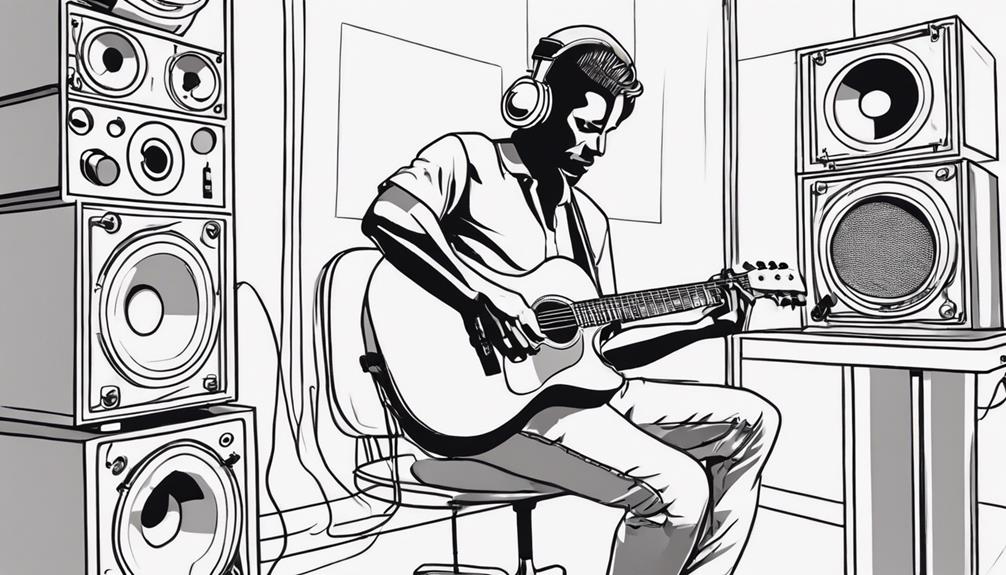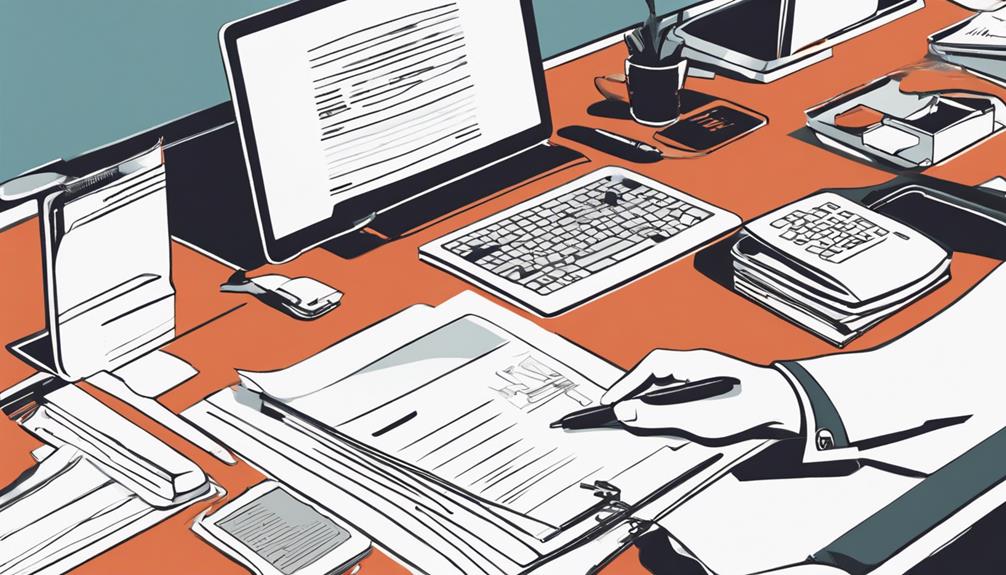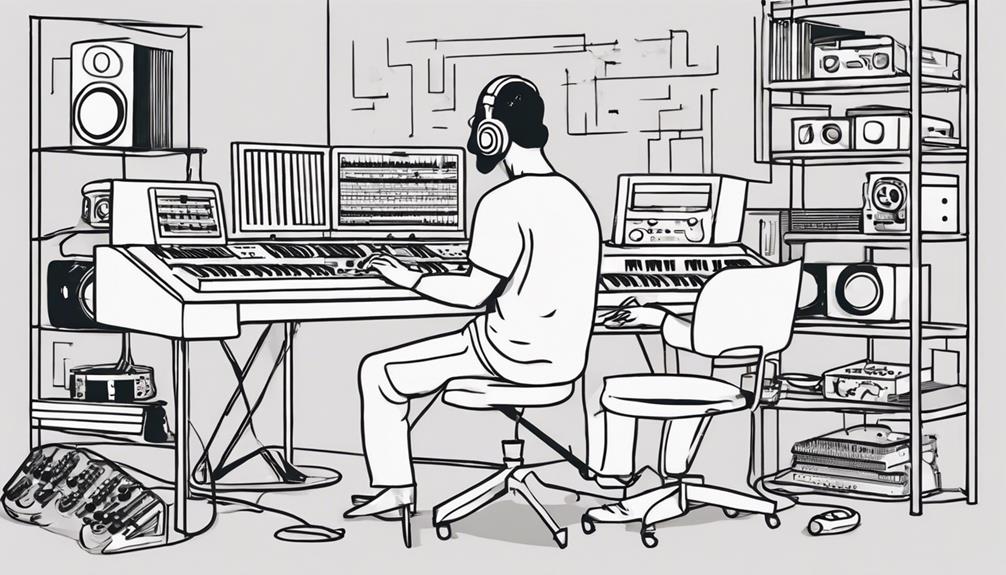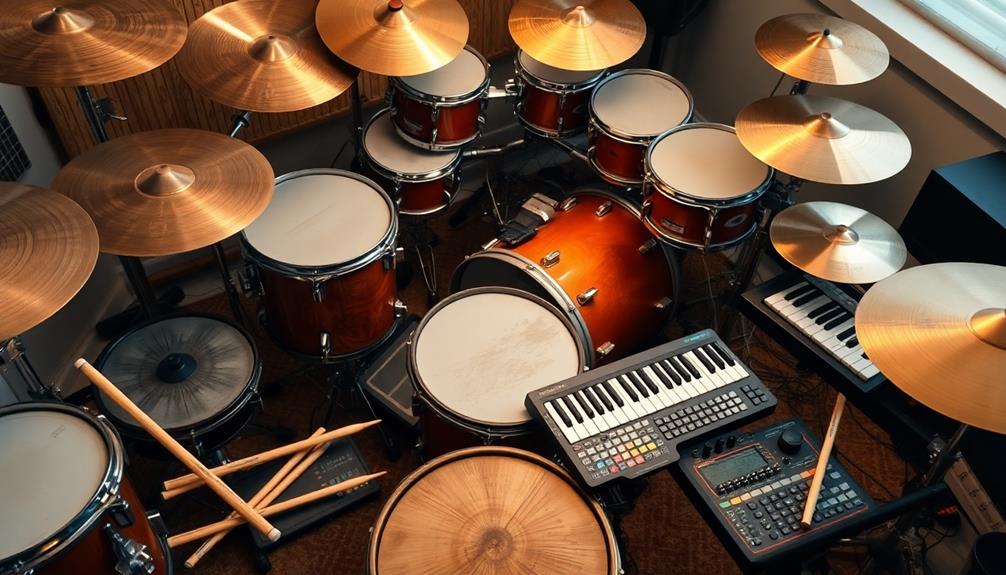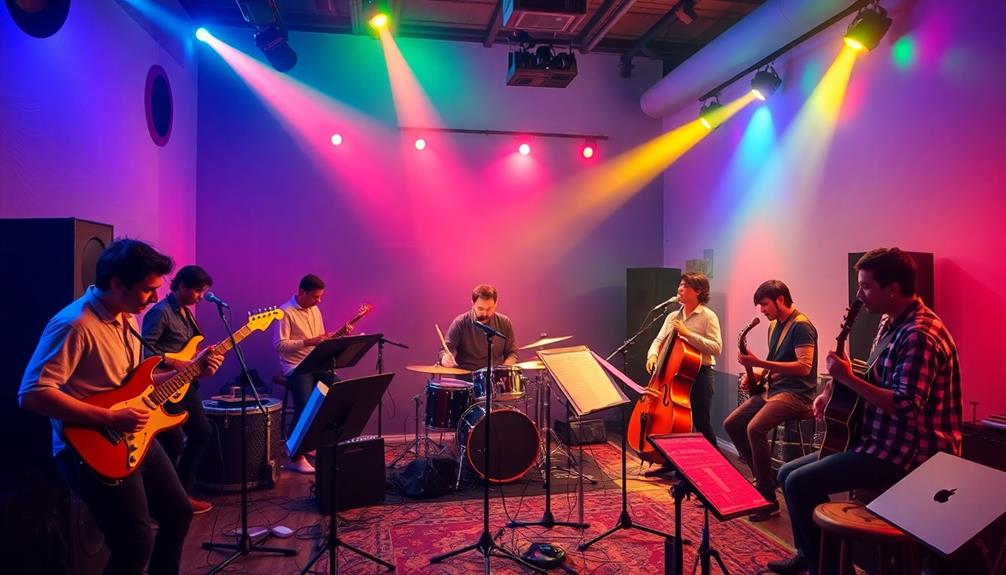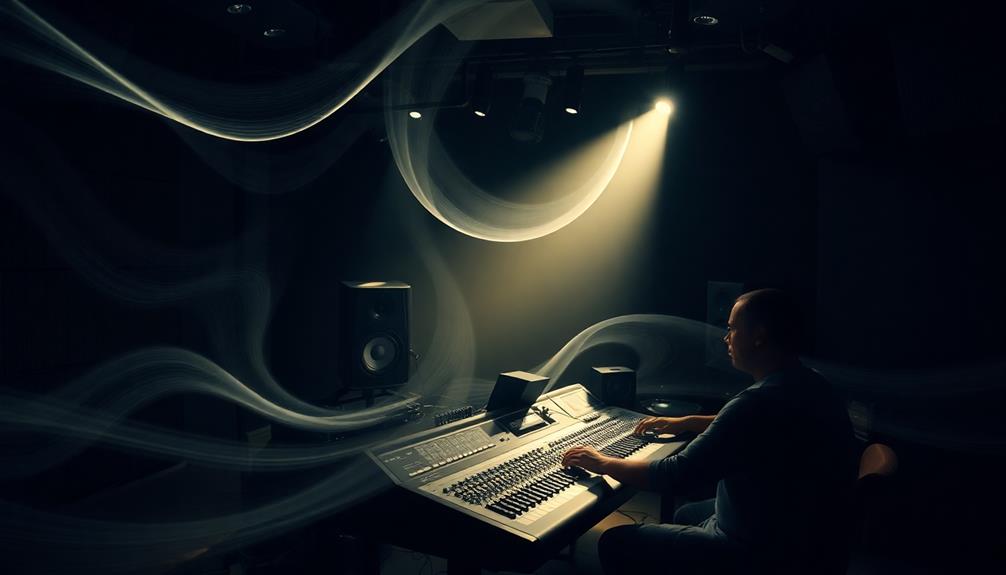To perfect your guitar sound in music production, start with tuning and intonation checks. Maintain a well-tuned guitar and guarantee proper signal chain quality. Monitor input levels around -6 dB for clean recordings. Experiment with effects like delays and reverbs, and try different microphone setups for best tone capture. Consider using amp simulations or high-quality amps. Develop recording skills by focusing on techniques like mic placement and software amp simulators. Enhance your sound with effects pedals and quality cables. Perfecting your guitar sound involves mastering various techniques and equipment choices.
Key Takeaways
- Ensure well-tuned guitar and optimal intonation.
- Experiment with effects, microphones, and amp settings.
- Set input levels carefully to prevent clipping.
- Use high-quality cables and connections.
- Focus on recording techniques for quality enhancement.
Guitar Setup Essentials
Make sure your guitar's setup is optimized for recording by checking tuning, intonation, and signal chain quality. A well-tuned guitar guarantees accurate pitches and harmonics in your recordings, while proper intonation maintains consistency across the fretboard.
Using high-quality cables and connections is essential to maintain signal integrity and minimize interference, resulting in clean and clear recordings. Experimenting with different guitar pickups can help you achieve the desired tone and sound quality for your music production projects.
Adjusting the EQ settings on your amplifier allows you to shape the frequency response and enhance your guitar's sonic characteristics, tailoring the sound to fit your vision. Additionally, consider incorporating effects pedals into your signal chain to add depth and texture to your guitar tones, expanding your sonic palette and creating unique sounds in your recordings.
Tuning and Intonation Tips
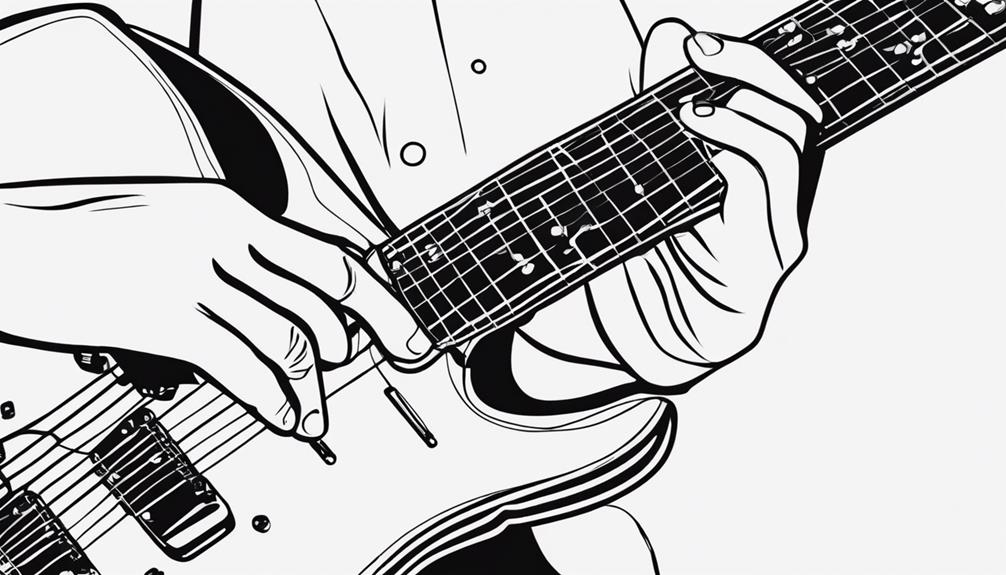
Ensuring proper tuning and intonation on your guitar is essential for achieving pitch accuracy and consistency in your recordings. To perfect your guitar tone, follow these tips:
- Tune to Standard: Start by tuning your guitar to standard tuning (EADGBE) using a digital tuner for precision.
- Check Intonation: Play fretted notes at the 12th fret and adjust saddle positions to guarantee accurate pitch across the fretboard.
- Utilize Digital Tools: Make use of a digital tuner or tuning app for precise tuning and intonation adjustments to enhance sound quality.
- Regular Maintenance: Keep your guitar in top condition by regularly adjusting the truss rod, bridge, and nut for optimal recording performance.
- Attention to Detail: Proper tuning and intonation are essential for achieving a professional sound in your recordings, so pay close attention to these details for polished results.
Monitoring Input Levels
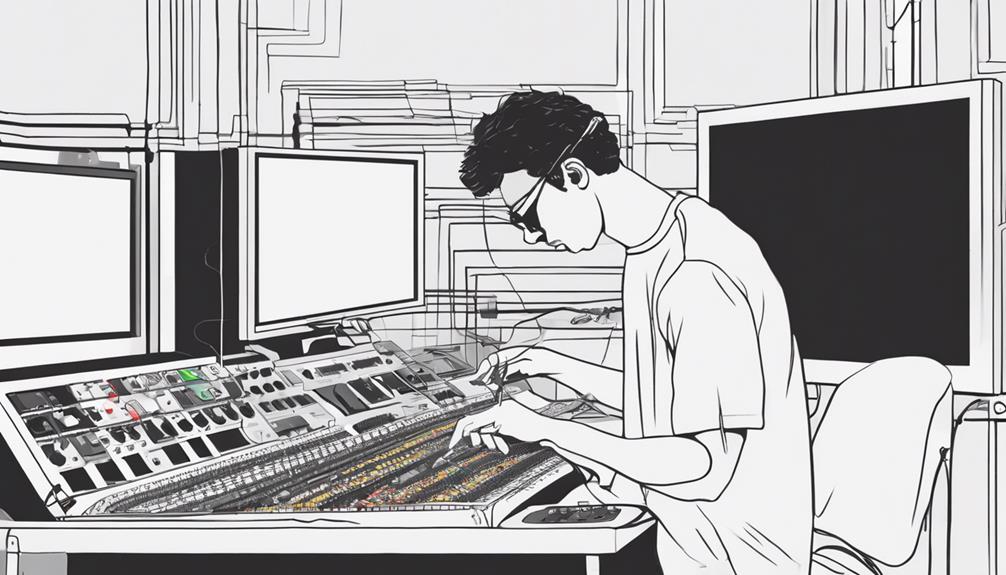
Monitor your input levels carefully to avoid unwanted distortion and clipping in your guitar recordings.
Setting ideal levels is essential for achieving a clean and professional sound.
Input Level Basics
To guarantee clean and dynamic guitar recordings, monitor your input levels to prevent digital clipping and distortion. Adjusting the input gain on your audio interface ensures you maintain a healthy signal without compromising quality.
Utilize visual indicators available on your recording software to keep an eye on input levels in real-time. Here are some key points to keep in mind when it comes to monitoring input levels effectively:
- Aim for a signal that peaks around -6 dB to -3 dB for best levels.
- Adjust input gain carefully to prevent clipping and distortion in recordings.
- Keep an eye on visual indicators to make sure a healthy signal is being captured.
- Properly set input levels are essential for achieving a clean and dynamic guitar recording.
- Monitoring input levels diligently helps in avoiding unwanted noise and maintaining overall recording quality.
Setting Optimal Levels
Keep a close eye on your input levels to prevent distortions and guarantee a clear signal when recording guitar for music production. To achieve optimized levels and ensure a professional-quality recording, it's crucial to monitor input levels carefully. Adjust the input gain on your audio interface or preamp to strike a balance that captures your guitar's dynamics without causing digital clipping. Keep a watchful eye on the input meters in your recording software, making sure they hit the sweet spot—not too low that you introduce noise, and not too high that you risk distortion. By aligning your input levels with the loudest parts of your playing, you maintain a balanced recording that captures all nuances. This approach not only helps in avoiding digital clipping issues but also contributes to a polished and professional sound.
| Input Levels Tips | |
|---|---|
| Adjust input gain | Set levels to capture dynamics without clipping |
| Monitor input levels | Keep an eye on input meters in recording software |
| Avoid digital clipping | Prevent distortion by ensuring levels are not too high |
| Balanced recording | Align levels with the loudest parts of your guitar playing for a dynamic recording |
| Professional-quality recording | Properly setting input levels leads to a polished and clean sound |
Avoiding Clipping Issues
Be vigilant in observing the input levels on your audio interface to prevent digital clipping issues during guitar recording sessions. Monitoring input levels is essential to guarantee a clean and distortion-free sound.
Here are some tips to help you avoid clipping problems:
- Regularly check the input meters on your audio interface or recording software.
- Adjust the gain levels on your audio interface or preamp to maintain a healthy signal level.
- Keep the input signal below 0 dB to prevent clipping issues.
- Be cautious of sudden spikes in volume that could lead to clipping.
Remember that preventing clipping not only preserves audio quality but also protects your equipment from potential damage. By staying mindful of your input levels and making necessary adjustments, you can achieve professional and pristine guitar recordings.
Experimenting With Effects and Microphones
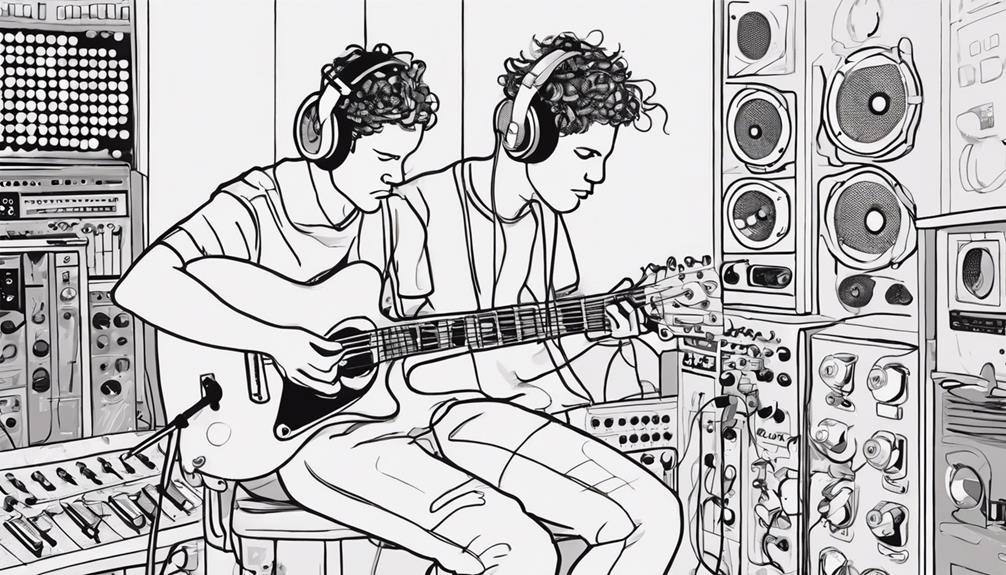
Try out different guitar effects like delays, reverbs, and distortions to add richness to your sound.
Experiment with mixing dynamic and condenser microphones to capture the full spectrum of your guitar's tones.
Find your unique sound by playing around with effects pedals and microphone placements to create a sonic landscape that complements your playing style.
Effects for Guitar
Experimenting with effects and microphones can greatly enhance the depth and richness of your guitar sound in music production. To perfect your sound, consider the following:
- Try out different effects pedals such as overdrive, delay, and reverb to add dimension to your guitar tones.
- Experiment with various microphone placements to capture the nuances of each effect pedal and create unique sounds.
- Utilize EQ adjustments in your effects chain to shape your sound and make sure it fits well within the mix.
- Create a layered and textured guitar sound by combining different effects and microphone techniques.
- Explore the impact of effects and microphones on various music styles, from clean tones to heavy distortion.
Microphone Placement Tips
When capturing the perfect guitar sound in music production, exploring various microphone placement techniques becomes crucial to enhancing the depth and richness of your recordings.
Experiment with different microphone placement by trying various distances and angles in front of the guitar speaker to capture a range of tones.
Utilize different microphone types such as dynamic, condenser, or ribbon to achieve unique sound characteristics and textures.
Adjust the microphone position to the center or edge of the speaker cone for different frequency responses and tonal qualities.
Additionally, consider adding effects like reverb, delay, or modulation during recording to enhance the guitar sound and add depth to the mix.
To guarantee cleaner recordings, use isolation boxes or amp shields to reduce room reflections and external noise interference.
Finding Your Sound
To develop your unique guitar sound, delve into exploring a variety of effects pedals and microphone placements to uncover a world of sonic possibilities.
When discovering your sound, experiment with the following:
- Explore Different Effects Pedals: Test out distortion, delay, reverb, and chorus effects to shape your electric guitar tone.
- Experiment with Various Microphone Placements: Try out close-miking and room miking techniques to capture the best tone from your amp.
- Consider Dynamic and Condenser Microphones: Combine these microphone types for a balanced and detailed guitar recording.
- Adjust Mic Distance from the Amp Speaker: Play around with distance to control brightness and warmth in your guitar tone.
- Use Software Amp Simulators: Integrate virtual effects and amp simulators for a wide range of sonic options when recording at home.
Utilizing Quality Amps or Modelers
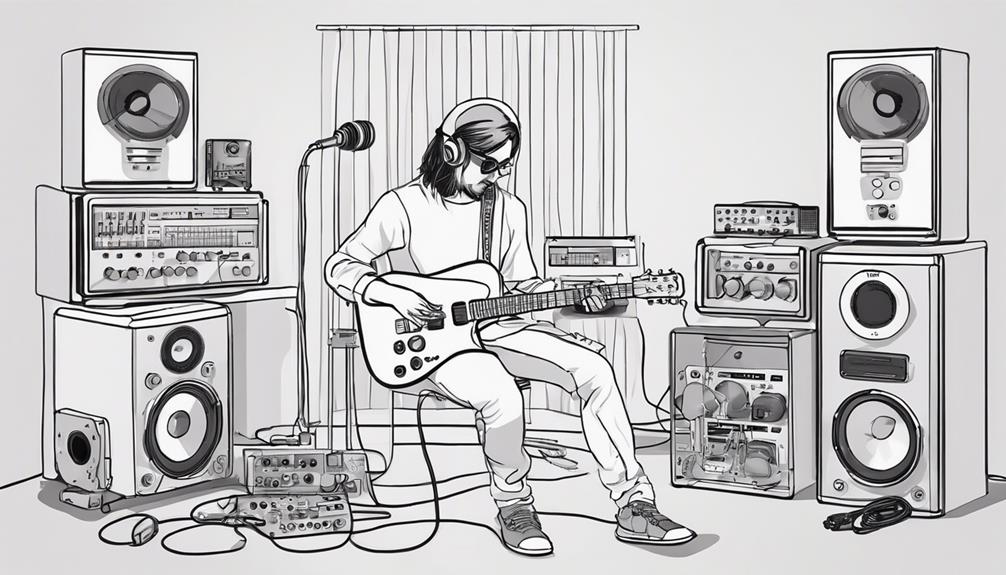
For achieving diverse and professional guitar tones in music production, consider utilizing quality amps or modelers like Line 6 Helix or Kemper Profiler. These amp modelers offer a wide range of amp simulations, effects, and cabinet emulations that can elevate your recording guitar experience.
Whether you're working with electric guitars at home or in a professional recording setting, having a premium amp around can make a significant difference in the quality of your sound. The Line 6 Helix, for example, provides a plethora of amp models and effects designed to cater to various music genres and styles.
On the other hand, the Kemper Profiler excels in replicating the nuances of tube amp tones in a compact digital format. These high-end amp modelers not only offer convenience and consistency but also allow you to save presets and switch between different amp configurations seamlessly.
Investing in a quality amp modeler can streamline your recording process, saving you space, time, and money while delivering premium guitar tones for your music productions.
Developing Recording Skills and Techniques

Experimenting with microphone placement is key to capturing the best guitar tone and dynamics when developing your recording skills and techniques.
To enhance your guitar recordings, consider the following:
- Utilize high-quality recording equipment such as the Shure SM-57 microphone for a professional sound.
- Record multiple guitar tracks to create layers and depth in your music production.
- Focus on proper intonation and tuning to guarantee a clean and precise guitar recording.
- Incorporate third-party plug-ins and effects to add depth and character to your guitar sound.
- Experiment with different mic placements, such as close-miking or room miking, to achieve varying tones and textures.
Enhancing Music Production Quality
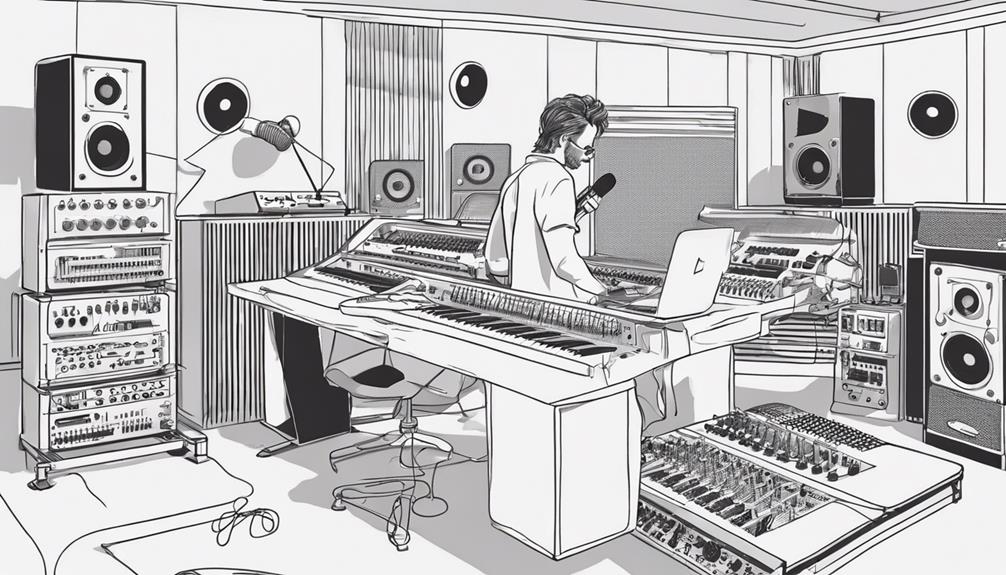
Enhance your music production quality by incorporating high-quality cables and experimenting with different guitar pickups to achieve a professional sound. When recording your electric guitar, focus on adjusting the tone using the amp simulator to get the desired guitar sound.
Experiment with various pickup configurations to find the perfect tone for your tracks. Additionally, pay attention to how you position the microphone when capturing the guitar sound to guarantee excellent recording quality in your home studio setup.
Utilize effects pedals strategically to add depth and texture to your recordings. Mastering the art of mixing and mastering is essential to achieving a polished final product. Remember to optimize EQ settings on the amplifier and experiment with different recording techniques and equipment to elevate your music production quality.
With the right tools and techniques, you can enhance the overall sound of your guitar recordings and take your music to the next level.
Frequently Asked Questions
How Do I Make My Guitar Sound Better When Recording?
To make your guitar sound better when recording, experiment with microphone placements, use high-quality cables, adjust EQ settings on the amp, add effects pedals strategically, and invest in a professional guitar setup for peak sound quality.
How Do You Record a Guitar Perfectly?
To record a guitar flawlessly, place the microphone close to the speaker for excellent sound. Experiment with placements for the finest tone. Use high-quality cables and gear. Combine dynamic and condenser mics. Adjust EQ settings for a polished sound.
How Can I Make My Guitar Sound Perfect?
To make your guitar sound perfect, experiment with microphone placements, use high-quality cables, adjust EQ settings on your amp, add effects pedals, and consider professional setup services for peak sound quality. These steps will help you achieve the ideal guitar tone for recording.
How to Record Guitar Clearly?
To record your guitar clearly, position a cardioid dynamic mic like the Shure SM57 in front of the speaker cone. Experiment with placement for the best sound. Adjust amp EQ for balance. Capture multiple takes for nuanced clarity. Consider using a pop filter for clear vocals.
Conclusion
Now that you've mastered recording guitar for music production, you're basically a rockstar in the making! Your sound is polished, your skills are on point, and your music production quality is excellent. With all the expertise you’ve gained, why not take your talent to the next level? This could be the perfect time to start a music production company and share your unique sound with the world. By combining your passion for music with your production skills, you’ll be well on your way to creating something truly unforgettable.
Keep experimenting, keep practicing, and keep perfecting your sound. Who knows, the next big hit could be just a strum away!

